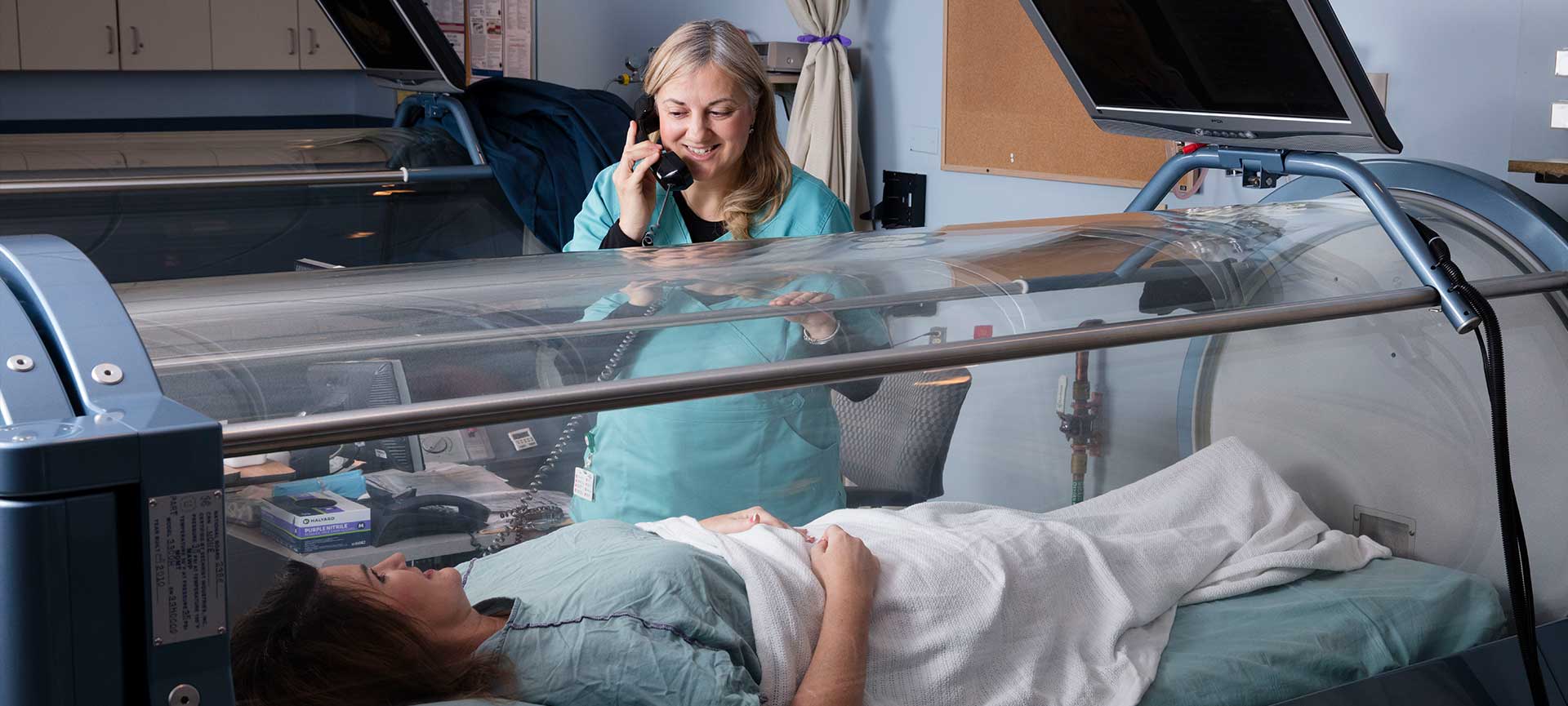Hyperbaric Oxygen Therapy at GBMC
Frequently Asked Questions
How does the treatment process begin?
Hyperbaric Oxygen Therapy (HBOT) is a prescribed medical treatment. Your physician must provide a referral for evaluation by the hyperbaric medicine team. During this evaluation, our physicians and nurses will assess your medical condition to determine if HBOT is appropriate for you. If you are a suitable candidate, the treatment process will be thoroughly explained. To schedule a consultation, we will need a referral from your physician. Once the consultation is scheduled, you will need to provide the following upon check-in:
- Photo identification
- Insurance card(s)
- A list of current medications
- A list of your medical providers
What should I expect during my visit?
Throughout your HBOT treatment, you will be cared for by a specialized team of physicians, advanced practice providers, nurses, and certified hyperbaric technologists. Before each treatment session:
- You will change into an approved treatment gown.
- Your vital signs and blood sugar (if applicable) will be checked.
- A provider will perform a physical examination, including an assessment of your ears, heart, and lungs.
Once you are deemed safe for treatment, you will be escorted to the hyperbaric chamber. You will lie on a reclining bed and be positioned comfortably. The chamber is clear, allowing you to watch television or streaming services during the treatment. During the session, you may feel pressure in your ears or sinuses, similar to what you experience during airplane travel. You will be instructed on techniques to relieve this pressure. You may also notice a slight temperature change and the sound of air circulating in the chamber. Each treatment typically lasts approximately two hours, and you will be continuously monitored by the hyperbaric team to ensure your safety and comfort.
What are the potential side effects?
Before starting treatment, you will be screened for any medical conditions or medications that may increase your risk of side effects. Your treatment plan will be tailored to minimize these risks, but side effects may still occur.
Less serious side effects may include:
- Discomfort in the middle ear and sinuses due to pressure changes
- Temporary vision changes, which usually resolve a few weeks after completing therapy
- Anxiety or claustrophobia, which can be managed with pre-medication if necessary
- A drop in blood sugar, typically prevented by screening before treatment
Rare but more serious side effects include:
- Oxygen toxicity: High oxygen levels can cause nausea, ringing in the ears, vision changes, muscle twitching, irritability, or other symptoms. Inform your hyperbaric technologist immediately if you experience any of these to prevent a seizure.
- Ear barotrauma: Failure to report ear pain could lead to a ruptured eardrum.
- Pulmonary barotrauma: Holding your breath during treatment could result in lung collapse (pneumothorax).
- Fire hazard: Bringing prohibited items into the chamber could cause a fire.
Will my insurance cover treatment?
Medicare and most other third-party payers cover Hyperbaric Oxygen Therapy for approved medical conditions. If your insurance requires prior authorization, we will obtain it before starting treatment. Any financial concerns will be discussed with you in advance.
How often are treatments?
The number of treatments you need depends on your medical condition and how you respond to therapy. Most treatment plans involve daily sessions, four days a week, with each session lasting about two hours. Patients typically receive between 10 and 80 treatments. If you cannot adhere to the recommended schedule, the treatment may be discontinued as irregular therapy can reduce effectiveness.
What items are prohibited in the chamber?
For safety reasons, only approved items are allowed inside the hyperbaric chamber. You will undergo a safety screening before each treatment. Prohibited items include, but are not limited to:
- Makeup, perfume, aftershave, hairspray, hair oils
- Wigs, hairpieces, hair extensions, false eyelashes
- Nail polish
- Alcohol or petroleum-based products
- Cell phones, pagers, and other electronic devices
- Metallic items (e.g., jewelry, titanium-frame eyeglasses, keys, coins, etc.)
- Flammable or heat-producing items (e.g., heating pads, lighters, cigarettes)
- Hearing aids
- Paper products (e.g., books, magazines, newspapers)
- Food, gum, or candy
Can I take my contact lenses, glasses, or medical devices into the chamber?
Please inform the hyperbaric team of any medical devices or implants. The team will evaluate whether these items can safely be pressurized.
What if I am sick or on medication?
Notify the hyperbaric team if you have any of the following symptoms:
- Cold or cough
- Flu-like symptoms (fever, chills, sore throat)
- Nausea, vomiting, or diarrhea
Inform the staff about any medications you are taking or if there are changes to your medication regimen. In some cases, decongestants may be recommended to prevent ear or sinus discomfort.
What if I am diabetic?
If you have diabetes, maintain your regular diet and take prescribed medications to manage your blood sugar. Your blood glucose levels will be tested before and after each treatment. Blood glucose monitors and insulin pumps are not permitted in the chamber.
Can I drive to and from my HBOT appointments?
Most patients can safely drive themselves to and from their HBOT sessions. Please allocate approximately two and a half hours for each visit.
What if I need to use the bathroom during treatment?
It is recommended that you use the restroom before beginning treatment. If needed, staff will provide a urinal or bedpan for use inside the chamber.
Are visitors allowed during my treatment?
To maintain patient confidentiality, visitors are not permitted inside the treatment area. If you have special circumstances, discuss them with a hyperbaric team member. Family and friends may wait in the designated area outside the treatment room.
